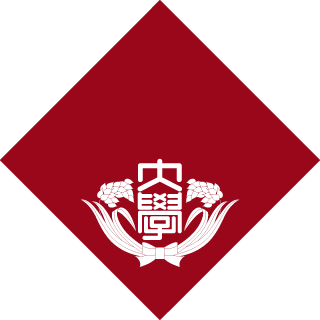Meg Block VanSchoorl
Waseda University International Division
1971 – 1972
My Waseda Story
(日本語は英語の次にあります)
Introduction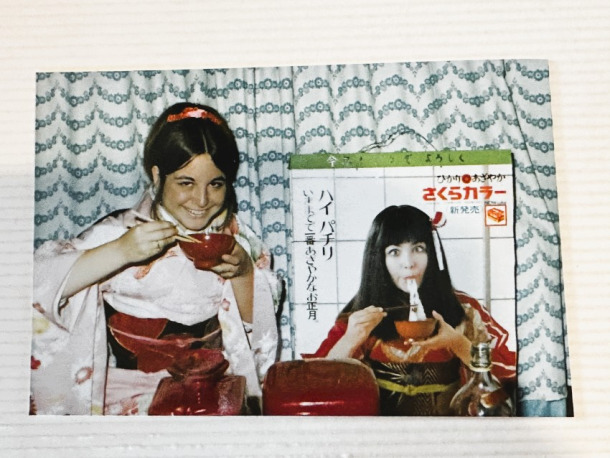
When I look into the rear-view mirror of time and trace the trajectory of my life, even from a distance now of 53 years, I consider my year at Waseda University, living with the Mitsui family and traveling throughout Japan, among the most impactful and richexperiences of my entire lifetime.
Choosing Japan
As a 20-year-old English major at Occidental College in my hometown of Los Angeles in 1971, applying for a year in Japan now seems like a wildly bold choice, both in terms of my own limited life experience and in the context of the times. Up until then, my international travel consisted of one trip to Mexico with my mother! Hard to comprehend now but we did not have cell phones, personal computers, email accounts, 24-hour news, PayPal, or WhatsApp. We had landline phones with exorbitant three-minute charges. The fastest regular means of written correspondence was via blue tri-fold airmail letters. And to be completely honest, negative memories of World War II in the Pacific were still firmly entrenched in the minds of many Americans, which made this choice inexplicable even to some of my family.
Unlike today’s expansive offerings, back in the day, colleges had limited programs abroad. Occidental had just three: two in Europe and one in Japan. I decided on Japan for two reasons: I had attended Audubon, a multicultural junior high school, during which I became good friends with “sansei” who had given me a glimpse into their heritage. I also reasoned that European countries would be much easier to navigate independently than Japan (ironically, it would be 1993 before I traveled to Europe!)
Once I was selected for the Japan Study Abroad program, I decided I should learn a few words of Japanese (it was not a program requirement and was not offered as a class at Occidental). I found a Japanese graduate student on campus who was willing to teach me the essentials like “my name is…” “nice to meet you,” and, most importantly, “where is the bathroom”! I also needed to declare a major other than English if I hoped to graduate from Occidental in 1973 as planned. So, I switched to a major called “Religion and Literature” under the Department of Religious Studies because I could take International Division classes at Waseda (Kokusaibu) in Japanese and Asian literature and religion and have the credits fully count towards my Bachelor of Arts Degree at Occidental.
Our 10-hour plane trip from Los Angeles to Tokyo was broken up by a layover in Anchorage, Alaska. Arriving at Haneda Airport in the morning late in August 1971, my first impression was how stiflingly hot the air was. We were met by officials representing Waseda and within the next day or two we were matched with our host families and began classes.
Homestay with the Mitsui Family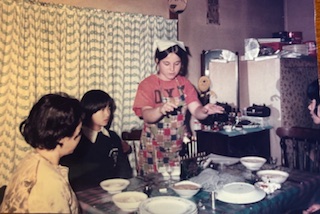
I honestly do not know how I was lucky enough to be matched with the Mitsui family for my homestay. Tadashi and Nobuko Mitsui owned a camera store and attached home that was located about 30 minutes from Takadanobaba in the middle of a bustling and noisy retail area called “Nabeyokocho” near the Marunouchi Line Shin Nakano Station. The Mitsuis sold photographic equipment and developed film in their storefront. They raised their three daughters Emiko (22 years old), Mitsuko (19 years old), and Kumiko (14 years old) in a small home at the back of and above the store.
I was given my own tatami mat room on the second floor overlooking the street. I shared their food, the nightly ofuro, and so many meaningful conversations and laughter. I called Tadashi “Otosan,” Nobuko “Okasan,” and I really did consider them my parents. They showed me every kindness. On many Sundays, despite working 6-day weeks, Otosan would take me by train to walk in nature on the outskirts of Tokyo.
I was the second Kokusaibu student the Mitsui family hosted. Amazingly, they went on to host at least eighteen additional Kokusaibu students every year after me. Even more amazing is the back story as to why this happened.
Otosan was a young man around 1940-41 when he decided to visit his cousins in the western United States. His timing unfortunately coincided with the onset of World War II in the Pacific and the 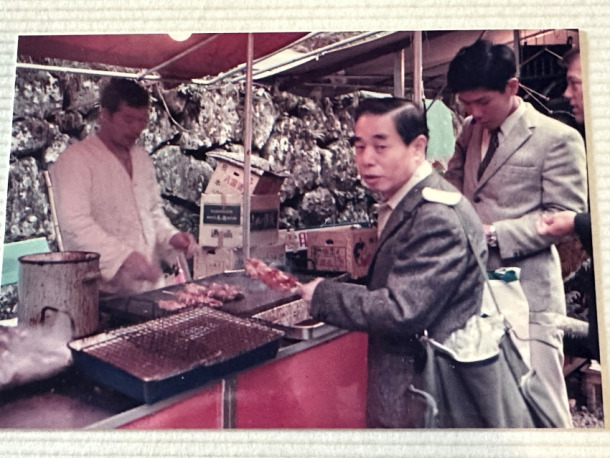 forcible relocation of people of Japanese descent from the US West Coast into internment camps. Otosan and his cousins were relocated and detained in the camps. At some point, perhaps after the camps were closed, he returned to Japan and started his adult life. Otosan was somehow able to come away from this experience with positive impressions of America and of Americans. He translated these feelings of good will into opening his home, family, and heart to twenty young Americans. And I was one of the fortunate beneficiaries.
forcible relocation of people of Japanese descent from the US West Coast into internment camps. Otosan and his cousins were relocated and detained in the camps. At some point, perhaps after the camps were closed, he returned to Japan and started his adult life. Otosan was somehow able to come away from this experience with positive impressions of America and of Americans. He translated these feelings of good will into opening his home, family, and heart to twenty young Americans. And I was one of the fortunate beneficiaries.
The Waseda Experience
Fundamental to success in daily life, relationships, and travel in Japan was learning Japanese. Of course, we were immersed in it within our host families and our community interactions, but having intensive 1.5 hours of daily formal instruction at Waseda was a lifesaver. Mostly this meant conversational Japanese, hiragana, and katakana, but also as many kanji as could fit in my small brain. My Japanese language classes were taught by two women whose names I sadly do not recall but in my mind’s eye I clearly see their open, smiling faces. The tools they gave us were a critical part of becoming comfortable in Japan.
I took classes that fit my college major, delving into Japanese and Asian religious traditions, as well as classic and contemporary Japanese literature. Additionally, I took Japanese history, art, and even an impressive law course from the famed intellectual property professor emeritus . Another of my most indelible memories was fulfilling a religious studies final paper requirement by spending a couple of days and nights at the Ittoen Commune near Kyoto. I observed its residents not only praying but practicing their beliefs by performing humble acts like cleaning public toilets in the countryside.
I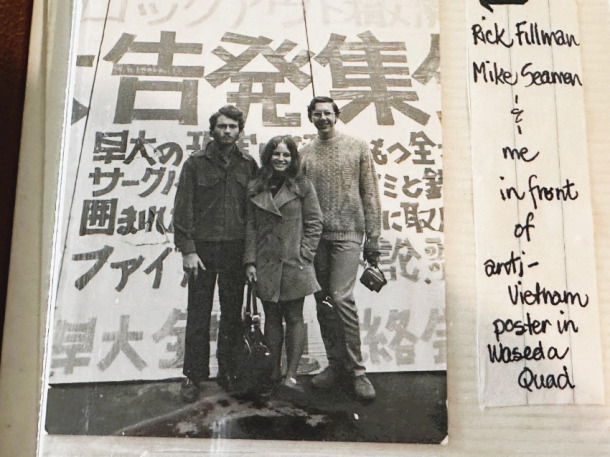 mportantly, Waseda also ensured that our learning took place in Tokyo outside of the Kokusaibu walls. I remember field trips to see Kabuki, Noh, Bunraku, temples and gardens, the Imperial Palace, tea ceremonies, and the incredible Sumo tournament. Beyond exposure to traditional Japan, we were encouraged to learn about the realities of contemporary Japan. We socialized with “regular” Waseda students. One such contemporary was He was generous with his time and friendship, inviting us to meals in his family’s home and even introducing us to Waseda-Keio baseball games and how to cheer with umbrellas to the Waseda Fight Song! Akio went on to become a lawyer, an expert in international trade, and he retired as Waseda Law Professor Emeritus and is still a good friend. The Waseda campus was also a place for us to learn that student protests were not limited to those in the United States. Some protests related to the Vietnam War. More intense were protests driven towards reducing US bases in Japan generally and most notably, towards reversion of Okinawa from the US to Japan which was ratified in May 1972.
mportantly, Waseda also ensured that our learning took place in Tokyo outside of the Kokusaibu walls. I remember field trips to see Kabuki, Noh, Bunraku, temples and gardens, the Imperial Palace, tea ceremonies, and the incredible Sumo tournament. Beyond exposure to traditional Japan, we were encouraged to learn about the realities of contemporary Japan. We socialized with “regular” Waseda students. One such contemporary was He was generous with his time and friendship, inviting us to meals in his family’s home and even introducing us to Waseda-Keio baseball games and how to cheer with umbrellas to the Waseda Fight Song! Akio went on to become a lawyer, an expert in international trade, and he retired as Waseda Law Professor Emeritus and is still a good friend. The Waseda campus was also a place for us to learn that student protests were not limited to those in the United States. Some protests related to the Vietnam War. More intense were protests driven towards reducing US bases in Japan generally and most notably, towards reversion of Okinawa from the US to Japan which was ratified in May 1972.
Waseda also encouraged us to take advantage of free weekends and holidays to explore Japan. Often with my Occidental College friend Shelley Roberts, I traveled with Kokusaibu students and with Japanese friends, generally staying in youth hostels, and occasionally, Buddhist temples or ryokan. Trains were an efficient and scenic way to cover large distances. They could also be stressful – I remember constantly running late for a departure and having to sprint with a heavy backpack up and down steep stairways and over bridges to get to the tracks before the train doors closed. I have lasting memories of visiting Takayama, Gifu, Mashiko, the Kansai area, Seto Nai Kai, Fuji-Hakone-Izu, and many others. Seeing Hiroshima was the most emotional visit and is seared in my memory.
Having acquired some basic Japanese language skills had both positive and challenging aspects: While I could now walk up to people in rural areas and very confidently ask questions such as “sumimasen, eki wa doko desu ka?”, they then (understandably but incorrectly) assumed I would be able to understand their quickly delivered answers. We all quickly became experts at interpreting directional hand signals!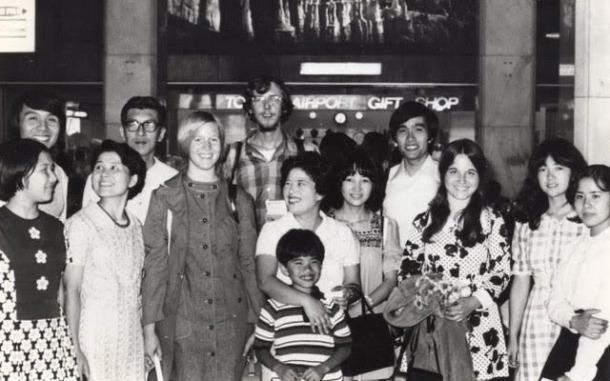
Having six weeks off of school in February and March provided an amazing opportunity for more extensive travel throughout Japan and Asia. The 1972 Sapporo Olympics was a prime destination for some classmates, while I chose an open-ticket month-long trip with two Kokusaibu friends to Hong Kong, Borneo, Thailand, and Malaysia. The adventures we had in Southeast Asia are for a different story, but our time living and traveling in Japan undoubtedly gave us the confidence to go even further afield.
Life Impacts
When I walked off the plane at Haneda that hot August day in 1971, I had no idea the impacts that my time at Waseda would have on my future life.
Right before graduating from Occidental College in June 1973, I saw a small notice in the Career Center asking for applicants to teach English at Hokkaido’s Komazawa University. Shelley and I were selected, along with a young woman from Hawaii. Life in Iwamizawa City differed in every way from life in Tokyo, but we happily continued our adventures with new host families, instructing students from preschool to college while navigating snow and ice from October to March.
After receiving a Master’s Degree in Public Policy from Claremont Graduate School, I relocated to Washington State and began a 35-year career in the Senate, the House of Representatives, and the Executive Branch. In the 1990’s, our Governor twice welcomed visitors from Hyogo Prefecture, our sister state. It was my pleasure in my professional economic development role to have business meetings with them and each time, my husband and I hosted two officials for weeklong homestays.
A few years later, my Japan experience helped me become the director of International Marketing for the Department of Agriculture. We conducted outbound trade missions to Japan to introduce Washington State farmers and food processors to potential importers, and we enthusiastically hosted inbound buyer missions from Japan. Always a highlight was treating our Japanese importers to Seattle Mariners baseball games where we rented a suite with perfect views of Ichiro Suzuki in all his right field glory!
Lastly: The self-confidence I gained from living in Japan gave me the foundation for being curious and comfortable out in the world. I have continued traveling – to Europe, Africa, and Asia – and have intentionally passed on this legacy to my children and grandchildren. Despite the fact that technological advances have interconnected our world to an extent unimaginable in 1971, I think that the need is greater than ever to champion programs like Waseda’s that cause young people to challenge their own assumptions and broaden their perspectives.
(Photos, from top to bottom: 1) At Mitsui Family home; 2) 3rd night of Hanukah prayer with the Mitsui family; 3) host dad, Tadashi Mitsui; 4) with Occidental College friends during protests on Waseda campus; 5) end of Study Abroad with Shelley, Rick, host families and Akio Shimizu; 6) with Occidental schoolmates Shelley and Rick. Photo taken from Waseda Kokusaibu Guide 1972-73 issue.)
メグ ブロッシュ ヴァンスクール
早稲田大学で過ごした私の一年
私の早稲田留学物語
はじめに
バックミラーを覗くように過去を振り返って自らの人生の軌跡をたどってみると、53年という時を経た今でさえ、早稲田大学での一年間、ミツイ家での生活、そして日本各地を旅した経験は、私の人生に最も影響を与えた、豊かな経験であったと思います。
日本を選んだ理由
1971年、当時20歳の私は、故郷ロサンゼルスのオクシデンタルカレッジで英語を専攻していました。まだたいした人生経験もなく、また当時の時代の風潮からしても、私が一年間の日本留学を志願したことは、今思えば驚くほど大胆な選択だったと思います。それまでの私の海外旅行経験といえば、母と行ったメキシコ旅行たった一度きりでした。今では理解し難いことですが、当時は携帯電話もパソコンもメールも四六時中流れてくるニュースもPayPalもWhatsAppもありませんでした。固定電話は3分ごとに法外な料金がかかる代物でした。最も速い書面での通信手段は、青い三つ折りのエアメールでした。そして包み隠さずに言うと、太平洋戦争の負の記憶が多くのアメリカ人の心に根深く残っていたため、この私の選択に、家族の中には理解を示さない者もいました。
今日、大学では一般的に豊富な留学プログラムが用意されていますが、当時の選択肢は限られていました。オクシデンタルカレッジにはヨーロッパが2つ、日本が1つの、合わせて3つの留学プログラムしかありませんでした。私が日本を選んだ理由は二つでした。一つは、国際色豊かなオーデュボン中学に通っていた頃、日系三世の友人たちと親しくなり、彼らの文化に触れる機会を得ていたこと。もう一つは、ヨーロッパの方が日本よりも個人旅行で行きやすいと思ったからです。(そしてなんと、私が初めてヨーロッパを訪れることになったのは1993年になってからでした!)
日本への留学が決まってすぐ、私は日本語を少し勉強しようと思い立ちましたが、日本語学習は留学プログラムに参加するための必須条件ではないうえに、オクシデンタルカレッジでは日本語の授業は開講されていませんでした。そこで私はキャンパス内で日本語を教えてくれる日本人大学院生を見つけ、「私の名前は…」「はじめまして」、そして最も重要な「トイレはどこですか?」といった最低限必要な会話を教えてもらいました。また、予定通り1973年にオクシデンタルカレッジを卒業するには、英語以外の専攻を決める必要がありました。そこで、宗教研究学科の「宗教と文学」という専攻に切り替えました。早稲田大学の「国際部」で日本語による日本・アジア文学と宗教の授業を受け、その単位をオクシデンタルカレッジの文学の学士号取得に全て充当できるからででした。
ロサンゼルスから東京までのフライトは、アラスカ州アンカレッジで乗り継いで、10時間かかりました。1971年8月下旬の朝、羽田空港に到着し私が抱いた第一印象は、息苦しさを感じるほど空気が蒸し暑いということでした。早稲田大学の関係者が出迎えに来ており、その翌日か翌々日にはホストファミリーが決まり、授業が始まりました。
ミツイ家でのホームステイ
私のホームステイ先がミツイ家に決まったのは、自分でも本当に幸運だったと思います。ミツイタダシさんとノブコさん夫妻は、丸ノ内線の新中野駅からほど近い「鍋屋横丁」と呼ばれる賑やかで騒がしい商店街の中心で、自宅に併設するカメラ店を営んでおり、高田馬場からは30分程の場所にありました。ミツイ家は店頭でカメラ機材を販売し、写真の現像も行っていました。彼らは店舗の二階と裏にある小さな家で暮らしており、長女エミコ(22歳)、次女ミツコ(19歳)、三女クミコ(14歳)の三姉妹を育てていました。
私は商店街を見下ろせる二階の畳の部屋を与えられました。食事も夜の風呂も共にし、笑い声と充実した会話が絶えませんでした。タダシさんを「お父さん」、ノブコさんを「お母さん」と呼び、心から実の両親のように慕っていました。二人は私に限りない思いやりを示してくれました。お父さんは週6日働いていたにもかかわらず、日曜日には電車で東京郊外へ自然散策に連れて行ってくれました。
私はミツイ家が受け入れた二人目の国際部の留学生でした。驚くべきことに、ミツイ家はその後も毎年、少なくとも合わせて18人以上の留学生を受け入れ続けたのです。さらに驚くべきは、その背景にある理由です。
お父さんは1940年から1941年頃、アメリカ西海岸に住んでいた彼のいとこ達を訪ねたそうです。その頃、不幸にも太平洋戦争が勃発し、西海岸在住の日系人が強制収容所へ移送される事態に遭遇しました。お父さんは彼のいとこたちと共に収容所に移送され、拘束されました。おそらく収容所が閉鎖された後、お父さんは日本へ帰国し、社会人としての生活を営み始めましたが、この経験から、どういうわけかアメリカとアメリカ人に対して好印象を持ち続けていたようです。この好意的な気持ちから、自身の家と、家族と、さらに心を開放して、20人の若いアメリカ人たちを迎え入れてきたのです。そして私は、その幸運な恩恵を受けた一人だったのです。
早稲田大学での経験
日本での日常生活も人間関係も国内旅行も、日本語が上達すれば全て上手くいくようになりました。もちろん、ホストファミリーや地域社会との交流で日本語に浸かる機会はありましたが、早稲田大学で受講した毎日1時間半の集中授業がとても役に立ちました。主に会話、ひらがな、カタカナが中心でしたが、私の小さな脳に収まる限りの漢字も学びました。日本語クラスを担当してくれた二人の女性教員の名前は残念ながら覚えていませんが、彼女たちの明るく微笑む笑顔が今でも鮮明に焼き付いています。彼女たちが授けてくれた知識は、日本で快適に生活するための重要な礎となりました。
大学の専攻に合った授業を履修し、日本とアジアの宗教的な慣習、古典および現代日本文学を深く学びました。それに加えて日本史や日本美術の講義も受講し、さらには著名な知的財産権の大家である土井輝雄名誉教授による法律の講義にも感銘を受けました。もう一つの忘れがたい思い出は、宗教研究の期末論文の課題として、京都近郊の一燈園のコミューンで数日間を過ごしたことです。そこで私は、住民たちが祈るだけでなく、田舎の公衆トイレを掃除するといった謙虚な行為を通じて信仰を実践する姿を目の当たりにしたのでした。
さらに大事なこととして、早稲田大学は、私たちの学びが国際部の中だけでなく、東京のあらゆる場所で実行できるようにサポートしてくれたことでした。歌舞伎や能、文楽、寺院や庭園、皇居、茶道、そして圧巻の相撲の興行を見学した数々の校外学習をよく覚えています。また、日本の伝統に触れるだけでなく、現代日本の現実も学ぶように導いてくれました。私たちは同年代の早大生とも交流し、そのうちの一人に清水章雄さんがいました。彼は時間を惜しむことなく私たちに友情を示し、彼の実家での食事に招いてくれただけでなく、野球の早慶戦に連れて行き、早稲田の応援歌に合わせて傘で応援する方法を教えてくれたのです。章雄さんは後に弁護士となり、国際貿易の専門家として活躍し、早稲田大学法学部名誉教授として退官後の今も、良き友人です。また早稲田大学のキャンパスは、学生運動がアメリカだけの現象ではないことを学ぶ場でもありました。ベトナム戦争関連の抗議活動もありましたが、より激しかったのは、在日米軍基地の削減を求める運動、特に1972年5月に批准された沖縄返還を求める抗議活動でした。
早稲田大学は、週末や休暇を利用して日本の他の地域を巡ることも奨励していました。私は、オクシデンタルカレッジの友人であるシェリー・ロバーツとよく、国際部の学生たちや日本人の友人たちを交えて旅行し、たいていはユースホステル、時には仏教寺院や旅館に泊まりました。電車での移動は、長距離を移動するのに効率的で、景色も楽しめました。しかし、大変なこともありました。出発時間にいつも遅れてしまい、重いリュックを背負って急な階段を駆け上がったり下りたり、跨線橋を走って渡り、列車のドアが閉まる直前にホームにたどり着いたこともよく覚えています。高山、岐阜、益子、関西地方、瀬戸内海方面、富士、箱根、伊豆など、その他にも多くの場所を訪れた思い出は今でも心に残っています。中でも広島は最も心を震わされた訪問先であり、その記憶は私の脳裏に焼き付いています。
基本的な日本語スキルを身につけたことで、良い面もあれば難しい面もありました。田舎で人に「すみません、駅はどこですか?」と自信を持って尋ねられるようになった一方で、相手は(当然ながらそうではないのに)私が早口で答えても理解できると思い込んでしまうのです。私たちは皆すぐに、方向を示す手の動きを解釈する達人になりました。
また2月から3月にかけて6週間の春休みがあったおかげで、日本中やアジア各地にまで広く旅する素晴らしい機会にも恵まれました。クラスメイトの中には、1972年に開催された札幌オリンピックを主な目的地に選んだ人もいましたが、私は国際部の友人2人とオープンチケットで香港、ボルネオ、タイ、マレーシアを巡る1ヶ月の旅を選びました。東南アジアでの冒険はまた別の話となりますが、日本での生活と旅行の経験が、さらに遠くへ踏み出す自信を私たちに与えてくれたことは間違いないでしょう。
私の人生に与えた影響
1971年8月のあの暑い日、羽田空港で飛行機から降り立った時、早稲田大学で過ごす一年が、自分の将来の人生に与える影響など、まったく想像もしていませんでした。
オクシデンタルカレッジを卒業する直前の1973年6月、に、キャリアセンターで北海道の駒澤大学で英語を教える教員を募集する小さな告知を見かけました。シェリーと私は、ハワイ出身の若い女性と共に選ばれました。岩見沢市の生活は東京とはあらゆる面で違っていましたが、私たちは新しいホストファミリーのもとで幸せな冒険を続け、10月から3月までは雪と氷の中を移動しながら、幼稚園児から大学生までを指導しました。
クレアモント大学院で公共政策の修士号を取得後、ワシントン州に移住し、上院、下院、行政機関において35年にわたるキャリアをスタートさせました。1990年代には、ワシントン州の州知事が、姉妹都市である兵庫県からの訪問団を歓迎したことが二度ありました。経済開発担当官として職務の一環で、彼らとの会議の機会を得たことは光栄であり、その度に夫と共に兵庫県の職員2人を、我が家で一週間のホームステイにお迎えしました。
数年後には、日本での経験のおかげで、私は農務省の国際マーケティング部長に就任しました。ワシントン州の農家や食品加工業者を日本の輸入業者に紹介するため、貿易促進ミッションを日本へ派遣し、また日本からのバイヤー一行を積極的に歓待しました。その際のハイライトは、シアトル・マリナーズの野球観戦へのご招待でした。私たちはスイートルームを貸し切り、ライトで輝くイチロー選手のプレーを完璧な眺めで楽しんでいただきました。
最後に
日本で生活したことで得た自信は私にとって、世界中で好奇心を持って気楽に振る舞える基盤となりました。私はその後も旅を続け、ヨーロッパ、アフリカ、アジアを訪れ、この旅の精神を意識的に子供や孫たちにも受け継いできました。1971年には想像もできなかったほど技術進歩が世界を結びつけたにもかかわらず、若者が固定観念にとらわれず挑戦し視野を広げるよう促す早稲田大学のような留学プログラムを推進する必要性は、今なお、かつてないほど高まっていると確信しています。
(写真は上から順に:1) ミツイ家にて;2) ミツイ家と一緒にハヌカの三日目の祈り;3) ホストファザーのミツイ・タダシ;4))
(Photos, from top to bottom: 1) At Mitsui Family home; 2) a prayer on the 3rd night of Hanukah, with the Mitsui family; 3) host dad, Tadashi Mitsui; 4) with Occidental College friends during protests on Waseda campus; 5) end of Study Abroad with Shelley, Rick, host families and Akio Shimizu; 6) with Occidental schoolmates Shelley and Rick. Photo taken from Waseda Kokusaibu Guide 1972-73 issue.)
